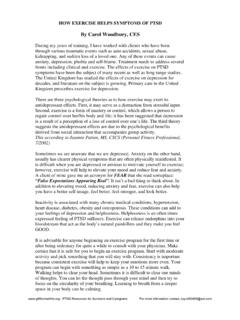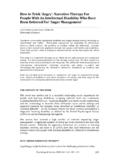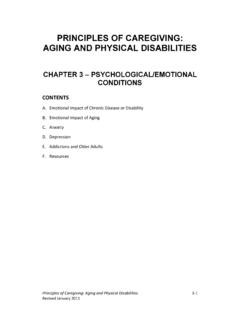Transcription of Post Traumatic Stress Disorder and the Workplace …
1 post Traumatic Stress Disorder and the Workplace What Employers and Coworkers Need to Know Amy Menna, , LMHC, CAP & Gift From Within post Traumatic Stress Disorder (PTSD) affects thousands of individuals across the world. It can be a debilitating illness that inhibits the individual's life. One of the many areas that PTSD affects is the work place. There are many individuals with PTSD who are able to work and are functioning at a level where they are able to hold a job; some successfully, and some just barely. The level of success one has at his or her place of employment depends on many factors including the level of impairment, and support outside and inside the work environment. This article is meant to address some of the pitfalls individuals with PTSD fall into at their place of employment, and how the individual's coworkers can provide support. As many have limited knowledge of PTSD, a brief synopsis will be given here.
2 Overview of PTSD. post Traumatic Stress Disorder can develop after a Traumatic event has occurred. One of the drawbacks some face is that it may not be recognized because the Traumatic event may not be readily seen. For instance, if someone comes home from war, we see them as a candidate for PTSD as most of us consider that a Traumatic event. However, hidden traumas such as childhood sexual abuse may not be disclosed or recognized therefore PTSD may not be considered. The components of PTSD are broken down into three main areas; intrusive, arousal, and avoidance symptoms. They exist primarily because of each other feeding off one another to sustain the existence of PTSD. Note that not every trauma survivor experiences all three symptoms. Some may experience one symptom more than another, and others may experience a different cycle. Although this is a pattern, it is not true for everyone. The following diagram depicts the relationship between the symptoms.
3 The three components combined create a cycle where the individual is constantly trying to catch up on life's challenges. The Workplace is one of those challenges which may be affected. The following outlines the three symptoms and provides examples of these symptoms. Intrusive Symptoms These are things that literally intrude on a survivor's life. They can be thoughts, feelings, or body memories. The individual experiencing these may feel as if the trauma is happening all over again. They may also have similar feelings or reactions as they did when the trauma occurred. Examples of intrusive symptoms are;. Flashbacks Nightmares Body memories Frightening thoughts Gina works in the finance office at a small corporation. She has a history of rape and childhood physical abuse that lead to symptoms of PTSD. At work, she has a supervisor that appears very threatening as he walks into her office without knocking and stands over her desk when he is angry about the business not making enough money.
4 Her boss's actions cause feelings of when she was overpowered during her assault. Her supervisor has the same physique and she feels threatened, just like during the assault. After he leaves the office, she feels frightened and has memories of the assault, as if it is happening right now. Arousal Symptoms Arousal symptoms literally arouse the body to get into a heightened state of alert. When a survivor is having intrusive thoughts or feelings that the event is happening again, it is natural for the body to respond with anxiety. Examples of arousal symptoms are;. Feeling tense Hyper-vigilance Excessive anxiety or worry Anger outbursts Startles easily/jumpiness Over reacts to others emotions and outbursts Reacts to others' traumas (such as EMS, hospital or police department). Gina feels irritable and jumpy at work. On bad days, she feels anxiety and terror when she hears that her supervisor is in a particularly bad mood or the company is not doing well financially.
5 Now, when someone even knocks on her door she practically jumps out of her seat. Avoidance Symptoms When you have unwanted thoughts and feelings intruding on your life and your body is in a heightened state of arousal to guard against harm, it is natural to want to escape. This phenomenon is part of what brings on avoidance symptoms. Avoidance symptoms are just that, they are symptoms that allow you to avoid your feelings and what you are experiencing in the moment. Examples of avoidance symptoms are;. Avoiding places and people associated with the trauma Loss of memory Loss of interest in once important activities Difficulty falling asleep Feeling distant Self-harming As a result of all the Stress , Gina has had a difficult time falling asleep at night. She dreads going to work in the morning. When there is a meeting that her supervisor runs, she makes an excuse not to go. Lately, she has been calling in sick all together.
6 She wants to reach out to her co-workers but she just doesn't know what to say and doesn't feel as if they would understand. Symptoms at work PTSD affects many facets of a survivor's life. One place is in the Workplace . PTSD can manifest itself in various ways in the Workplace following the symptoms above. It can be triggered or exacerbated by the work environment. The list is abbreviated as each individual has his or her own reactions, coping skills, as well as work environment. Some examples of problems associated with the Workplace for those who have PTSD are: Memory problems Lack of concentration Difficulty retaining information Feelings of fear or anxiety Physical problems Poor interactions with coworkers Unreasonable reactions to situations that trigger memories Absenteeism Interruptions if employee is still in an abusive relationship, harassing phone calls, etc. Trouble staying awake Panic attacks Gina's performance evaluations started to slip.
7 She was cited for missing work, overlooking simple things, and not getting things done in a timely manner. She was given the opportunity to remedy the situation; however, she had a difficult time concentrating and had a hard time interacting with her supervisor without getting flooded with emotions. Many of her co-workers were getting frustrated with her because they felt she wasn't doing her job correctly. They saw her missing meetings and calling in sick to work frequently. The president of the company felt that it was a personality conflict with the supervisor and nothing more. She was seen as someone who needed reprimand more than assistance. Accommodations Accommodating an employee with PTSD can be complex and is unique for each individual. What may be helpful for one individual may not be helpful for the next. First and foremost, it is important for the employer to be educated on PTSD and its symptoms. Knowledge can lead to understanding reactions, which may seem out of the ordinary.
8 It can also provide a framework for adapting the work environment to suit the needs of the individual with PTSD. Employers and supervisors Some things that supervisor can do to assist the employee with PTSD are;. Listen to the employee's limitations related to job performance. For instance, if a woman has a history of sexual assault that occurred during the night and fears walking alone, she may request to have someone walk her to her car at night. She may even request not to work after dark. Identify what specific tasks may be challenging. At times, PTSD symptoms may manifest themselves in cognitive challenges. An employee may need more time to finish a task or need an office which has less distractions. Identify specifically how you can assist. The best way to find out how you can assist someone is to ask. This may be something that develops over time as the employee may not be aware of limitations until he or she runs into them.
9 An open dialogue about how the employer can assist would be helpful from the beginning. Some survivors of abuse will feel embarrassed to admit they need help, so it is important to keep asking. You want to balance this and insure that you are making yourself available versus being overly persistent and aggressive. If a woman has been put down she may need to be encouraged to add input, acknowledging her input is valued. Evaluate the effectiveness of the environment and the employee. If there are times that the employee is having a hard time or tasks that are not up to standards, speak directly to that employee about how you can assist them. Providing gentle and immediate feedback will allow the employee to determine what is needed to get the task back up to standards. This is not to say that all substandard work is due to PTSD symptoms, but it is helpful to know the origins of the problem. Provide training for coworkers and supervisors.
10 By providing training on PTSD and related symptoms, the other staff members can also be educated on how to help the individual. Sensitivity training may be needed on topics that are related to PTSD. After some time, Gina realized that her work performance and mental health had been impacted by her work and decided to get help. With the help of her Employee Assistance Program, she found a therapist who assisted her in identifying her triggers at work. She was able to speak to her supervisor at work and discuss what was going on with her and request some accommodations be made for her to be more productive. Gina's supervisor did not realize that his behavior was triggering her. Together, they discussed what he could do to better support her. The first thing they decided was for him to start knocking and get permission to enter her office. Next, he agreed to meet with the team and have some pamphlets available on PTSD and how to provide support.









